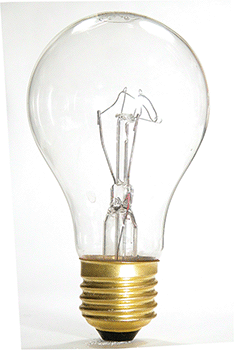Future Dims for Incandescent Bulbs
Wednesday, January 15th, 2014January 15, 2014
Stocks of incandescent light bulbs dwindled in January 2014 as manufacturers ceased production of 40- and 60-watt lamps. These wattages joined 75- and 100-watt incandescents in light-bulb limbo. They were phased out of production in 2012 and 2013, respectively. The phase-out was the result of the Energy Independence and Security Act signed by President George W. Bush in 2007. The regulation does not outlaw the sale or use of incandescents, but it restricts companies from manufacturing or importing them.
Incandescent lights bulbs, the oldest kind of light bulb, produce light by passing electric current through a metal wire called a filament. The filament heats up and glows. But in the process, about 90 percent of the electric current’s energy goes to waste as it turns to heat. The Energy Independence and Security Act aimed to reduce such waste.

An incandescent light bulb was the first kind of light bulb invented. It uses a thin metal wire called a filament. Passing an electric current through the filament causes it to glow. © Michael Germann, Shutterstock
Newer electric lights, including compact fluorescent lights (CFL’s) and light-emitting diodes (LED’s), are more expensive than incandescents, but they last much longer and waste far less electric power. Savings from reduced electric bills often make these more efficient light bulbs cheaper, in the long run, than incandescent bulbs. Using more efficient light bulbs also leads to less pollution from power plants that burn fossil fuels.
While some early CFL’s cast a harsh-colored light and flickered upon turning on, modern CFL’s and LED’s turn on smoothly and can mimic the type of light produced by incandescent bulbs. Even so, some customers rushed to hoard 40- and 60-watt incandescents before they disappeared from store shelves permanently.
Additional World Book articles:


